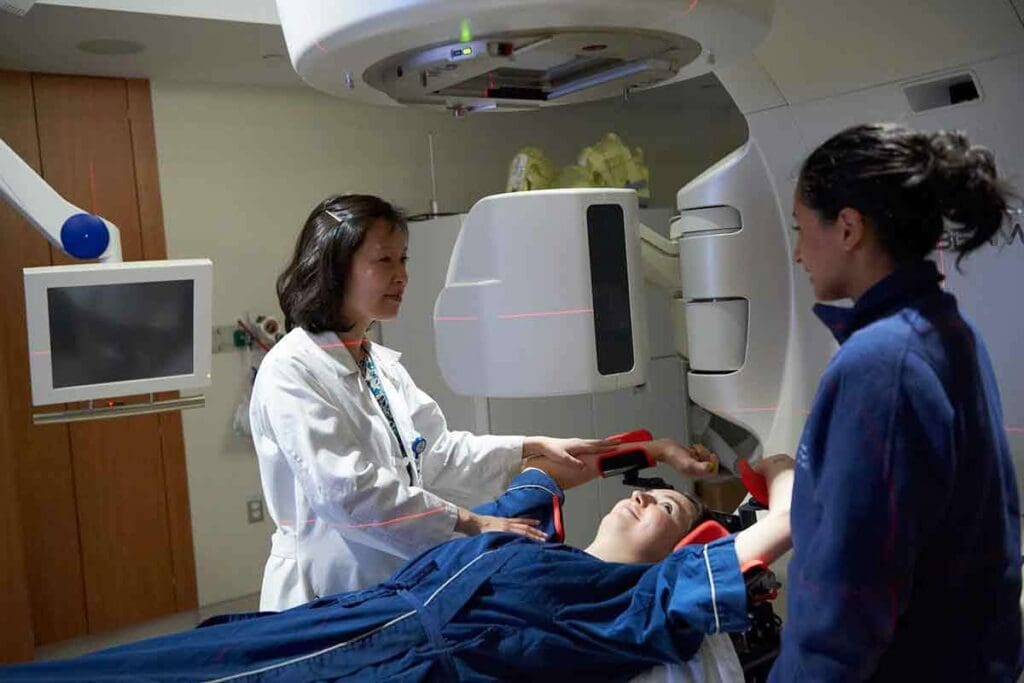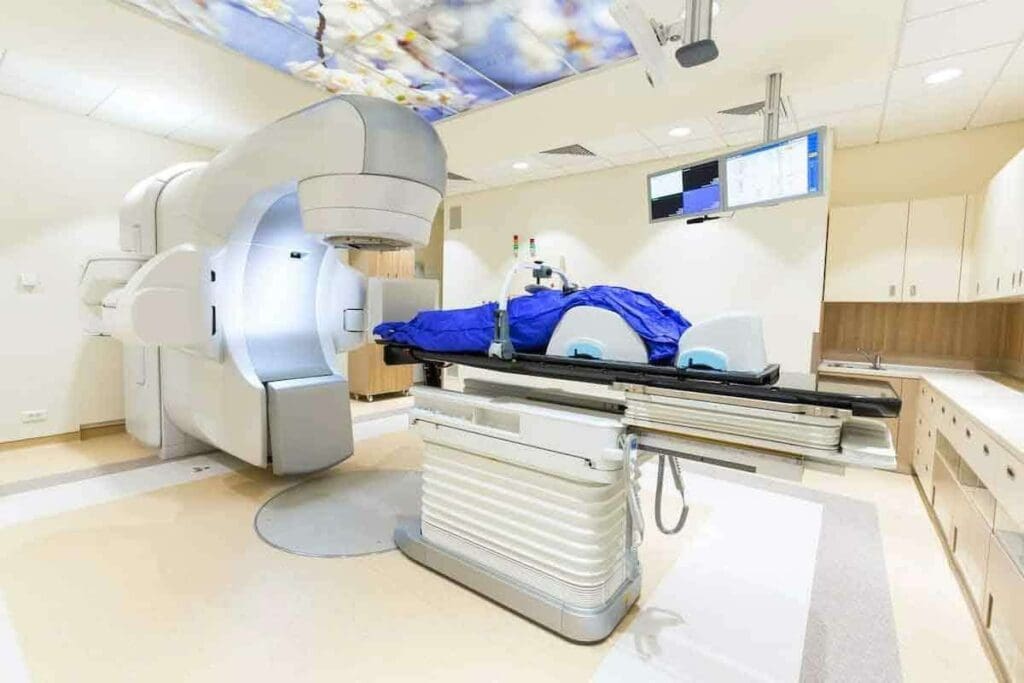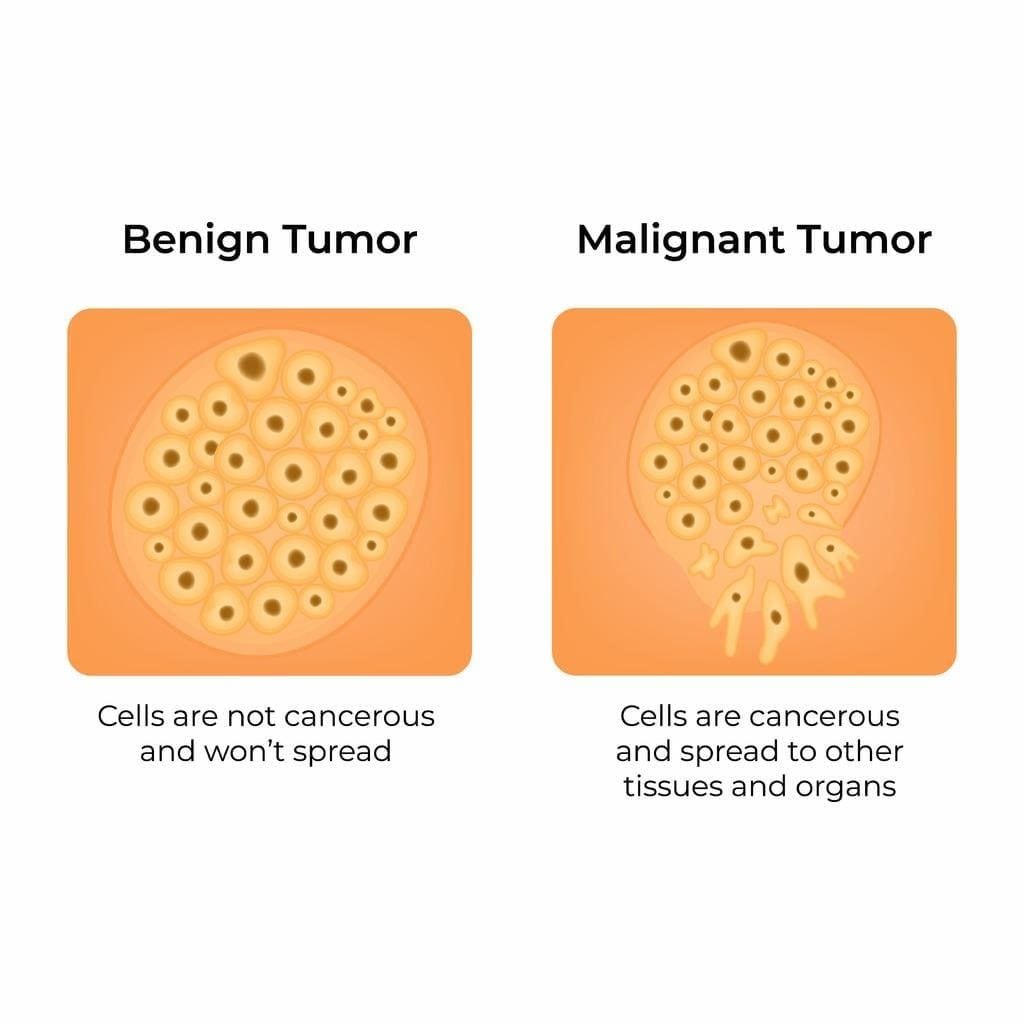Last Updated on November 27, 2025 by Bilal Hasdemir

External beam radiation therapy (EBRT) is a key part of modern cancer treatment. EBRT sends high-energy beams from outside the body to tumor sites. This makes it a precise treatment that targets specific areas.
At places like Liv Hospital, the latest technology meets a patient-focused approach. This ensures each patient gets a treatment plan that fits their needs. It follows international guidelines for the best care.
Key Takeaways
- EBRT is a widely used form of cancer radiotherapy.
- It delivers high-energy radiation beams directly to tumor sites.
- External beam radiation therapy is a local treatment.
- Liv Hospital offers tailored beam radiotherapy plans.
- International standards of care are upheld in radiation oncology.
The Evolution of External Beam Radiation Therapy

External beam radiation therapy has gotten much better at fighting cancer. These machines, called linear accelerators, can hit tumors right on target. They do this without harming the healthy tissues around them.
From Discovery to Modern Medical Application
It all started with Wilhelm Conrad Röntgen’s discovery of X-rays in 1895. This led to the first use of radiation therapy for cancer. Over time, this therapy has changed a lot.
Now, we have advanced machines that can send precise doses of radiation to tumors. This makes treatment more effective.
Impact on Cancer Treatment Success Rates
Thanks to these advancements, cancer treatment has seen big improvements. Now, doctors can target tumors more accurately. This means better results for patients and fewer side effects.
Studies show that using the latest in radiation therapy has boosted survival rates. It also makes life better for those fighting cancer.
Modern radiation therapy keeps getting better. Scientists are always working to make treatments even more effective and safe for patients.
Fact 1: How Radiation Treatment Machines Deliver Targeted Therapy

Modern radiation treatment machines use advanced technology to target tumors. This technology is key in fighting cancer. It helps focus the treatment on tumors, protecting healthy tissues nearby.
Linear Accelerator Technology Explained
Linear accelerators are the main machines used in cancer treatment. They speed up electrons to create high-energy X-rays. These X-rays are then aimed at tumors, giving them a precise dose of radiation.
Key components of linear accelerators include:
- Electron gun: Produces the electrons that are accelerated.
- Accelerating structure: Where the electrons gain energy.
- Target: Where the electrons collide to produce X-rays.
- Collimator: Shapes the X-ray beam to match the tumor’s geometry.
Precision Targeting Mechanisms
Advanced imaging and computer systems help target tumors accurately. These tools help doctors plan treatments that hit the tumor hard but spare other tissues.
| Feature | Description | Benefit |
| 3D Imaging | Provides detailed images of the tumor and surrounding anatomy. | Accurate targeting of the tumor. |
| Computer Planning | Designs a treatment plan tailored to the patient’s specific needs. | Maximizes dose to tumor, minimizes exposure to healthy tissues. |
| Real-time Monitoring | Allows for adjustments during treatment to ensure accuracy. | Enhances treatment effectiveness and safety. |
By using linear accelerators and precision targeting, these machines offer effective treatments. This helps improve outcomes for cancer patients.
Fact 2: Types of Radiation Beams Used in External Therapy
External Beam Radiation Therapy (EBRT) uses different types of radiation beams to fight cancer. The choice of beam depends on the tumor’s type, location, and the patient’s health.
EBRT uses X-rays, protons, and electrons. Each has its own uses. A study on the National Institutes of Health website says the right beam is key to.
X-ray and Photon Radiation
X-rays and photons are common in EBRT. They come from linear accelerators and can reach deep into the body. This precision helps treat many cancers, even in sensitive areas.
Proton Beam Therapy
Proton Beam Therapy (PBT) uses protons instead of X-rays. Protons have a special property called the Bragg peak. This lets them focus most of their energy on the tumor, protecting healthy tissues. PBT is great for tumors close to important areas.
“Proton therapy has emerged as a valuable treatment option for certain types of cancer, improving outcomes and reducing side effects.”
Electron Beam Applications
Electron beams are used in EBRT too. They’re good for shallow tumors because they mainly affect the skin and just below. This makes them perfect for skin cancers and other surface lesions.
| Radiation Beam Type | Characteristics | Common Applications |
| X-ray/Photon | High-energy, deep penetration | Various cancers, including deep-seated tumors |
| Proton | Precise energy delivery (Bragg peak) | Tumors near critical structures, pediatric cases |
| Electron | Superficial energy deposition | Skin cancers, superficial lesions |
In conclusion, picking the right radiation beam in EBRT is vital. Knowing about X-rays, protons, and electrons helps in treating cancer effectively.
Fact 3: Advanced Imaging Systems in Radiation Treatment Machines
Advanced imaging systems are key in modern radiation treatment machines. They help target tumors with great precision.
3D Imaging Technology Integration
The use of 3D imaging technology has made radiation therapy more accurate. It creates detailed, three-dimensional models of tumors and tissues. This makes targeting tumors more precise.
Some key benefits of 3D imaging include:
- Improved tumor visualization
- Enhanced accuracy in radiation delivery
- Better sparing of healthy tissues
Computer Planning Systems
Computer planning systems help plan and simulate radiation treatment. They use advanced algorithms to optimize beam delivery. This ensures the tumor gets the right dose while protecting healthy tissues.
Real-time Monitoring Capabilities
Real-time monitoring lets us track tumor movement during treatment. This allows for adjustments to keep the beams on target. Even if the tumor moves due to breathing or other factors.
The mix of advanced imaging and real-time monitoring has greatly improved radiation therapy. It leads to better treatment results for patients.
Fact 4: Cancer Types Effectively Treated with External Beam Therapy
External beam radiation therapy (EBRT) is a key treatment for many cancers. It’s precise and effective, making it a top choice for treating tumors in different body parts.
Breast Cancer Applications
EBRT is often used for breast cancer after a lumpectomy. It helps kill any cancer cells left behind. This method is usually well-accepted by patients and lowers the chance of cancer coming back.
Prostate Cancer Treatment Protocols
In prostate cancer, EBRT targets the tumor with great accuracy. This reduces harm to healthy tissues nearby. Treatments like intensity-modulated radiation therapy (IMRT) are used to improve results.
Brain, Lung, and Other Solid Tumors
EBRT is also effective for tumors in the brain, lung, and other solid tumors. Its ability to focus high doses of radiation on the tumor is key. This makes it a vital treatment for tough cases.
EBRT’s ability to treat a wide range of cancers highlights its critical role in cancer care. Tailoring treatments to each patient’s needs helps achieve the best results.
Fact 5: The Treatment Process Using Radiation Treatment Machines
The treatment process with radiation treatment machines has several important steps. These steps make sure patients get safe and effective therapy.
Treatment Planning and Simulation
Treatment planning is the first step. Here, the radiation oncologist sets the target area and the right dose of radiation. They use imaging technologies like CT scans to find the tumor’s exact location.
Next, the simulation happens. The patient is placed in the same position as they will be during treatment. This ensures the treatment is accurate.
Daily Session Structure and Duration
Radiation therapy is given in daily sessions, five times a week, for weeks. Each session is short, lasting 15 to 30 minutes. But, the actual radiation time is just a few minutes.
The radiation treatment machine is carefully controlled. It delivers the right dose to the tumor while protecting healthy tissues.
Complete Treatment Course Timeline
The length of the treatment course depends on the cancer type, stage, and the patient’s health. It can last from a few weeks to months. During this time, regular checks are done to see how well the treatment is working.
Knowing the treatment process helps patients prepare. It reduces anxiety and makes following the treatment easier.
Fact 6: Cutting-Edge Technologies in Modern Radiation Treatment Machines
The newest radiation treatment machines use advanced technologies for better patient care. These systems make external beam radiation therapy more precise and effective.
Intensity-Modulated Radiation Therapy (IMRT)
Intensity-Modulated Radiation Therapy (IMRT) changes the intensity of the radiation beam. This method delivers radiation more accurately to the tumor, protecting healthy tissues. IMRT is key in treating complex tumors, leading to better results and fewer side effects.
Image-Guided Radiation Therapy (IGRT)
Image-Guided Radiation Therapy (IGRT) combines imaging with radiation therapy. It allows for real-time adjustments to ensure the tumor is targeted correctly. IGRT is great for tumors that move or are near important structures.
Stereotactic Body Radiation Therapy (SBRT)
Stereotactic Body Radiation Therapy (SBRT) focuses high doses of radiation on specific areas. It’s effective for certain cancers because it delivers high doses in a few treatments. SBRT works well for tumors in the lung, liver, and spine.
Volumetric Modulated Arc Therapy (VMAT)
Volumetric Modulated Arc Therapy (VMAT) is a form of IMRT that moves around the patient. It makes treatments faster and can improve how the dose is spread. VMAT is good for complex cases needing precise dose delivery.
Here’s a comparison of these technologies:
| Technology | Key Features | Clinical Applications |
| IMRT | Modulation of radiation beam intensity | Complex tumors, reducing side effects |
| IGRT | Real-time imaging and adjustment | Tumors subject to movement, near critical structures |
| SBRT | Highly focused, high doses in few fractions | Lung, liver, spine tumors |
| VMAT | Continuous arc delivery, improved dose distribution | Complex cases requiring high dose conformity |
“The integration of advanced technologies like IMRT, IGRT, SBRT, and VMAT into radiation treatment machines has revolutionized cancer therapy, improving precision and patient outcomes.” –
A Radiation Oncologist
Fact 7: Safety Features and Side Effect Management
Modern radiation therapy uses advanced safety features to treat tumors precisely. It also aims to protect healthy tissues from radiation. Machines are built with safety in mind to ensure effective treatment and lower risks for patients.
Built-in Safety Mechanisms
Radiation treatment machines have built-in safety mechanisms. These include checks and balances to prevent accidents or malfunctions. They are designed to fail-safe, catching and fixing issues quickly.
Minimizing Exposure to Healthy Tissues
The main goal of modern radiation therapy is to minimize exposure to healthy tissues. Technologies like IMRT and IGRT help target tumors accurately. This reduces harm to nearby healthy tissues.
Managing Common Side Effects
Radiation therapy can cause side effects, but many can be managed. Fatigue, skin irritation, and nausea are common. These can be treated with medicine and lifestyle changes.
Effective side effect management requires teamwork. Patients, oncologists, and healthcare teams work together. This way, patients can get treatment without losing quality of life.
Leading Manufacturers of Radiation Treatment Machines
Several top companies lead in radiation treatment technology. They offer new solutions for cancer therapy. These leaders have advanced machines with the latest tech.
Varian Medical Systems Technology
Varian Medical Systems is well-known for its radiation machines. They have a wide range of products and services. Their tech includes linear accelerators and planning systems for precise cancer treatment.
Varian aims to better patient results and make clinical work easier.
Elekta Linear Accelerators
Elekta is a big name in radiation machines, known for precise linear accelerators. Their tech aims for targeted therapy with fewer side effects. Elekta’s systems are used globally in cancer treatment centers.
Accuray Treatment Systems
Accuray focuses on radiosurgery and SBRT systems. Their CyberKnife system offers precise tumor treatment. Accuray’s solutions treat various cancers and conditions without surgery.
The top makers of radiation machines keep pushing the limits of cancer therapy. They work hard to improve treatment and patient care. Their dedication to research and development keeps radiation therapy a key part of cancer treatment today.
Future Innovations in External Beam Radiation Technology
The field of external beam radiation therapy is on the verge of a big change. New technologies are coming that will make treatments better. Researchers are working hard to find new ways to help patients.
Artificial Intelligence Integration
Artificial intelligence (AI) is now being used in radiation therapy. It helps plan and deliver treatments. AI looks at lots of data to make treatment plans better, leading to better results and fewer side effects.
AI also lets doctors spend more time with patients. It takes over some tasks, freeing up doctors to focus on care.
Adaptive Radiation Therapy
Adaptive radiation therapy is another big step forward. It lets doctors change treatment plans as needed. This is great because it keeps treatments effective and on target.
MRI-Guided Linear Accelerators
MRI-guided linear accelerators are changing how we treat cancer. They use real-time imaging to target tumors more accurately. This is key for cancers that move or change shape.
These new technologies in external beam radiation therapy will greatly improve cancer treatment. They offer hope for better outcomes and a better quality of life for patients.
Conclusion: The Transformative Impact of Advanced Radiation Treatment
Advanced radiation treatment machines have changed the game in radiation oncology. They’ve made treatments better and safer for patients. New technologies like intensity-modulated radiation therapy and image-guided radiation therapy help target tumors accurately. This reduces harm to healthy tissues.
These new machines have brought hope to cancer patients around the world. As technology keeps improving, treatments are getting more effective. This means better survival rates and a better quality of life for those fighting cancer.
The future of radiation treatment looks bright. With the help of advanced technologies like artificial intelligence and MRI-guided linear accelerators, treatments will get even more precise. Advanced radiation treatment is leading the way in cancer care, bringing hope to many.
FAQ
What is External Beam Radiation Therapy (EBRT)?
External Beam Radiation Therapy (EBRT) uses a machine to send beams of radiation to a body part. It targets cancer cells while protecting healthy tissues nearby.
How do radiation treatment machines deliver targeted therapy?
Machines use linear accelerator technology to make precise beams. These beams are then shaped and aimed at the tumor using advanced tools.
What types of radiation beams are used in EBRT?
EBRT often uses X-ray and photon radiation. It also includes proton beam therapy and electron beam applications, each with unique uses.
What is the role of advanced imaging systems in radiation treatment machines?
Advanced imaging systems are key. They include 3D imaging, computer planning, and real-time monitoring. These ensure accurate and precise radiation delivery.
What types of cancer can be effectively treated with EBRT?
EBRT treats many cancers, like breast, prostate, brain, and lung tumors. It’s often used with surgery and chemotherapy.
What is the treatment process using radiation treatment machines?
The process starts with planning and simulation. Then, daily radiation sessions follow. The total time depends on the cancer type and treatment plan.
What are some of the cutting-edge technologies used in modern radiation treatment machines?
Modern machines use advanced technologies. These include IMRT, IGRT, SBRT, and VMAT. They improve treatment precision and effectiveness.
How do radiation treatment machines ensure safety and minimize side effects?
Machines have built-in safety features. Treatment plans aim to protect healthy tissues. Strategies manage common side effects.
Who are the leading manufacturers of radiation treatment machines?
Top makers are Varian Medical Systems, Elekta, and Accuray. They offer innovative solutions for radiation oncology.
What future innovations can we expect in external beam radiation technology?
Future advancements include artificial intelligence and adaptive therapy. MRI-guided linear accelerators will also improve treatment precision and effectiveness.
What is the significance of beam radiation in cancer treatment?
Beam radiation is vital in cancer treatment. It targets tumors precisely, reducing damage to healthy tissues. It’s a key part of modern radiation oncology.
How does external beam therapy work?
External beam therapy sends radiation beams from outside the body to the tumor. A machine shapes and directs the beams to match the tumor’s size and shape.
What is radiation oncology?
Radiation oncology uses radiation therapy to treat cancer. Its goal is to cure or control the disease while minimizing side effects and improving life quality.
References
- National Cancer Institute. (2018). External Beam Radiation Therapy for Cancer. https://www.cancer.gov/about-cancer/treatment/types/radiation-therapy/external-beam
- RadiologyInfo.org. (2024). Linear Accelerator (LINAC). https://www.radiologyinfo.org/en/info/linac






